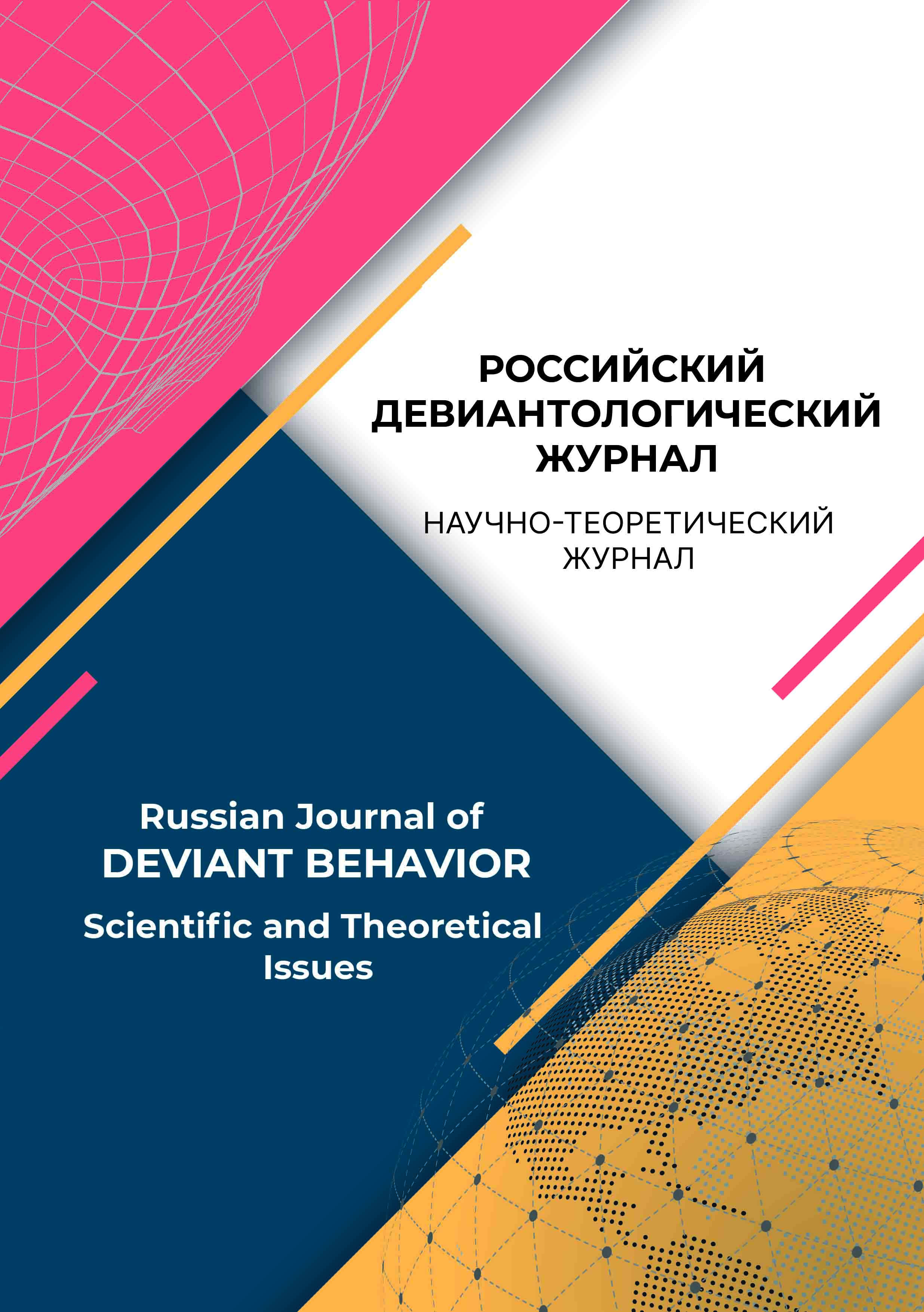Russian Federation
from 01.01.2020 until now
UDC 343
Live webcasts provide an opportunity for both streamers and their audience to participate in the digital social life of the community. This participation is connected, among other things, with the possibility of disseminating content that is considered socially harmful. Although “waste flow” have been popular in legal literature in Central Europe for several years, they have not yet been given due attention by representatives of forensic science. This study attempts to overcome the problem. Based on a long-term observation of the activity of “waste flows” and a thorough review of relevant legal literature and media reports, the authors provide a detailed description of “waste flows”, highlighting the differences in the terminology and definition used, in particular, in Poland and other foreign countries. The article provides some methodological guidelines to study “waste flows”. The authors have developed these recommendations on the basis of the literature analysis and their own research experience.
social pathology, online communication, live broadcast, hate speech, usergenerated content, trash content
1. Angielczyk, P. Z. (2019). Homo Crudelis in the Era of Internet. Parezja, 2 (12), 48-64.
2. Artwick, C. G. (2019). Social media livestreaming: Design for disruption? Abingdon: Routledge.
3. Bek, D., & Popiołek, M. (2019). Patostreaming - Characteristics and Legal Contexts of the Phenomenon. Zarzadzanie Mediami, 7 (4), 247-262. https://doi.org/10.4467/23540214ZM.19.021.11616
4. Bucher, T. (2015). Networking, or What the Social Means in Social Media. Social Media + Society, 1 (1). Retrieved from: https://doi.org/10.1177/2056305115578138
5. CNET News Staff (2018). YouTube’s Super Chat Hijacked for Hate Speech. Retrieved from: https://www.cnet.com/news/ youtubes-super-chat-hijacked-for-hate-speech/ (accessed: 25.07.2022).
6. Cyrek, B., & Popiołek, M. (2022). Trash streaming: characteristics and methodological guidelines. PRZEGLĄD KULTUROZNAWCZY, 3 (53), 445-458. https://doi.org/10.4467/20843860PK.22.029.16618
7. Davis, K. (2021). TWISTED TREND Inside Horrific ‘Death-Streaming’ Craze Where Viewers Pay to Watch Torture, Humiliation and Death Live on YouTube. Retrieved from: https://www.thesun.co.uk/news/14466280/russias-disturbing-trash-streaming-trend/
8. van Dijck, J. (2012). Facebook as a Tool for Producing Sociality and Connectivity. Television & New Media, 13 (2), 160-176. https://doi.org/10.1177/1527476411415291
9. Edge, N. (2013). Evolution of the Gaming Experience: Live Video Streaming and the Emergence of a New Web Community, The Elon Journal of Undergraduate Research in Communications, 4 (2), 33-39. Retrieved from: https://eloncdn. blob.core.windows.net/eu3/sites/153/2017/06/03NathanEdgeEJFall13.pdf
10. Fuller, M. Y., Mukhopadhyay, S., & Gardner, J. M. (2016). Using the Periscope Live Video-Streaming Application for Global Pathology Education: A Brief Introduction. Arch Pathol Lab Med, 140 (11), 1273-1280. https://doi.org/10.5858/ arpa.2016-0268-SA
11. Gilbert, M. A. (2019). Strengthening Your Social Media Marketing with Live Streaming Video. In Al-Masri, A., Curran, K. (Eds.), Smart Technologies and Innovation for a Sustainable Future (pp. 357-365). Advances in Science, Technology & Innovation. Springer, Cham. https://doi.org/10.1007/978-3-030-01659-3_42
12. Goldhaber, M. H. (1997). The Attention Economy and the Net. First Monday, 2 (4). https://doi.org/10.5210/fm.v2i4.519
13. Horsman, G. (2018). Reconstructing Streamed Video Content: A Case Study on YouTube and Facebook Live Stream Content in the Chrome Web Browser Cache. Digital Investigation, 26, S30-S37. https://doi.org/10.1016/j. diin.2018.04.017
14. Hu, M., Zhang, M., & Wang, Y. (2017). Why Do Audiences Choose to Keep Watching on Live Video Streaming Platforms? An Explanation of Dual Identification Framework. Computers in Human Behavior, 75, 594-606. https://doi.org/10.1016/j.chb.2017.06.006
15. Hu, Y., Tian, Y., Yang, W., Wang, X., & Zhang, X. (2020). Content to Cash: Understanding and Improving Crowdsourced Live Video Broadcasting Services with Monetary Donations. Computer Networks, 178, 107281. https://doi. org/10.1016/j.comnet.2020.107281
16. Jas, M. (2020). Patostreaming - the Dark Side of the Internet: Analysis of the Occurence on Selected Examples. Media Biznes Kultura, 1 (8), 169-180. https://doi.org/10.4467/25442554.MBK.20.012.12422
17. Kang, K., Lu, J., Guo, L., & Li, W. (2021). The Dynamic Effect of Interactivity on Customer Engagement Behavior through Tie Strength: Evidence from Live Streaming Commerce Platforms. International Journal of Information Management, 56 (2), 102251. https://doi.org/10.1016/j.ijinfomgt.2020.102251
18. Karaś, A. (2019). Patostreaming i jego społeczny odbiór. In A. Kampki (ed.), Doświadczanie społeczeństwa muzyka, obraz, media (pp. 222-235). Warszawa: Wydawnictwo SGGW.
19. Kmieciak-Goławska, A. (2018). Pathostreaming as a Way of Popularising the Subculture of Violence. Biuletyn Polskiego Towarzystwa Kryminologicznego im. Profesora Stanisława Batawii, 25, 171-183. https://doi.org/10.5281/zeno¬do.5005567
20. Kułaga, W., (2021). Transmission of Social Pathologies to the Internet: Threats Posed by Media Activity of Patoinfluencers, Patostreamers and Patousers. Com.press, 4 (2), 70-89. https://doi.org/10.51480/compress.2021.4-2.313
21. Laitinen, A., & Särkelä, A. (2019). Four Conceptions of Social Pathology. European Journal of Social Theory, 22 (1), 80-102. https://doi.org/10.1177/1368431018769
22. Lakshmi, S. (2022). The Alarming Rise in Content Creators Who Profit from Cruelty. An Injustice! Retrieved from: https://aninjusticemag.com/the-alarming-rise-in-content-creators-who-profitfrom-cruelty-da9401045210 (accessed: 25.07.2022).
23. Luxmoore, M. (2021). ‘Sign on and Take Part in Something Real’: Inside the Dark, Lucrative World of Russian ‘Trash-Streaming’. Radio Free Europe/Radio Liberty. Retrieved from: www.rferl.org/a/russia-trash-streamiing-dark-dares-pranks-lucrative-livestream-youtube/31123624.html (accessed: 25.07.2022).
24. Obszarny, M. (2019). Rafonix skazany za polowanie na „wykopka” w Piotrkowie. Sąd uznał, że to był samosąd. Dziennik Łódzki. Retrieved from: https://dzienniklodzki.pl/rafonix-skazany--za-polowanie-na-wykopka-w-piotrkowie-sad-uznal-ze-to-byl-samosad/ar/c1-14071477 (accessed: 25.07.2022).
25. Pawłowska, S., (2018). The Dark Nooks of YouTube - Patostreaming. Remedium, 6, 2-4.
26. Pradeep, M. (2021). ‘Trash Streaming’ Is a Disturbing YouTube Subculture Where Streamers Get Paid to Broadcast Abuse. ScreenShot. Retrieved from: https://screenshot-media.com/visual-cultures/internet-culture/trash-streaming-subculture/ (accessed: 25.07.2022).
27. Ryabikova, V. (2021). Welcome to the World of Russian Thrash Streams, Where People Get Insulted and Bullied for Money. Russia Beyond. Retrieved from: https://www.rbth.com/lifestyle/333280-welcome-to-world-of-russianp-trash-streams (accessed: 25.07.2022).
28. Santora, J. (2021). 75 Live Video Streaming Stats Every Marketer Should Know. Influencer Marketing Hub. Retrieved from: https://influencermarketinghub.com/live-streaming-stats (accessed: 25.07.2022).
29. Shen, Y.-C. (2021). What Do People Perceive in Watching Video Game Streaming? Eliciting Spectators’ Value Structures. Telematics and Informatics, 59, 101557. https://doi.org/10.1016/j.tele.2020.101557
30. Siedlanowski, P. (2018). Homo crudelis? Patostream - kolejna patologia w sieci, Biuletyn Edukacji Medialnej, 2, 44-57. Retrieved from: https://www.kul.pl/files/819/2_2018/siedlanowski_bem_2_2018.pdf
31. Sjöblom, M., & Hamari, J. (2017). Why Do People Watch Others Play Video Games? An Empirical Study on the Moti¬vations of Twitch Users. Computers in Human Behavior, 75, 985-996. https://doi.org/10.1016/j.chb.2016.10.019
32. The Storyteller, Russian Streamer Kills Pregnant Girlfriend Live for $1000 Tip (2021). Medium. Retrieved from: https:// medium.com/lessons-from-history/russian-streamer-kills-pregnantgirlfriend-live-for-1000-tip-a05755bd8cc4 (accessed: 25.07.2022).
33. Suler, J. (2004). The Online Disinhibition Effect. Cyberpsychology & Behavior, 7 (3), 321-326. https://doi. org/10.1089/1094931041291295
34. Tammy Lin, J. H., Bowman, N., Lin, S. F., & Chen, Y. S. (2019). Setting the Digital Stage: Defining Game Streaming as an Entertainment Experience. Entertainment Computing, 31, 100309. https://doi.org/10.1016/j.entcom.2019.100309
35. Törhönen, M., Giertz, J., Weiger, W. H., & Hamari, J. (2021). Streamers: The New Wave of Digital Entrepreneurship? Extant Corpus and Research Agenda. Electronic Commerce Research and Applications, 46 (1), 101027. https://doi. org/10.1016/j.elerap.2020.101027
36. Trash streaming (2021). Slang. Retrieved from: https://slangit.com/meaning/trash_streaming (accessed: 25.07.2022).
37. Tyszkowski, J. (2022). Trash streaming, czyli zarabianie na okrucieństwie. Dlaczego w Rosji jest to trend? Vibez. Retrieved from: https://vibez.pl/wydarzenia/trash-streaming-czyli-zarabianie-na-okrucienstwie-dlaczego-w-rosji-jest-to-trend-6743682085870144a (accessed: 25.07.2022).
38. Wojtyna, M. (2019). Boredom, Bovver, Subjectivity: Pathostream as Genre. Tekstualia, 3 (58), 55-70. https://doi. org/10.5604/01.3001.0013.6423
39. Wójcik, S., & Wojtasik, Ł. (eds.) (2019). Patocontent on the Internet: A Problem Report. Empowering Children Foundation. Warsaw.
40. Yu, E., Jung, C., Kim, H., & Jung, J. (2018). Impact of Viewer Engagement on Gift-giving in Live Video Streaming. Telematics and Informatics, 35 (5), 1450-1460. https://doi.org/10.1016/j.tele.2018.03.014














